SC Rewind: Years Ago - 1950s
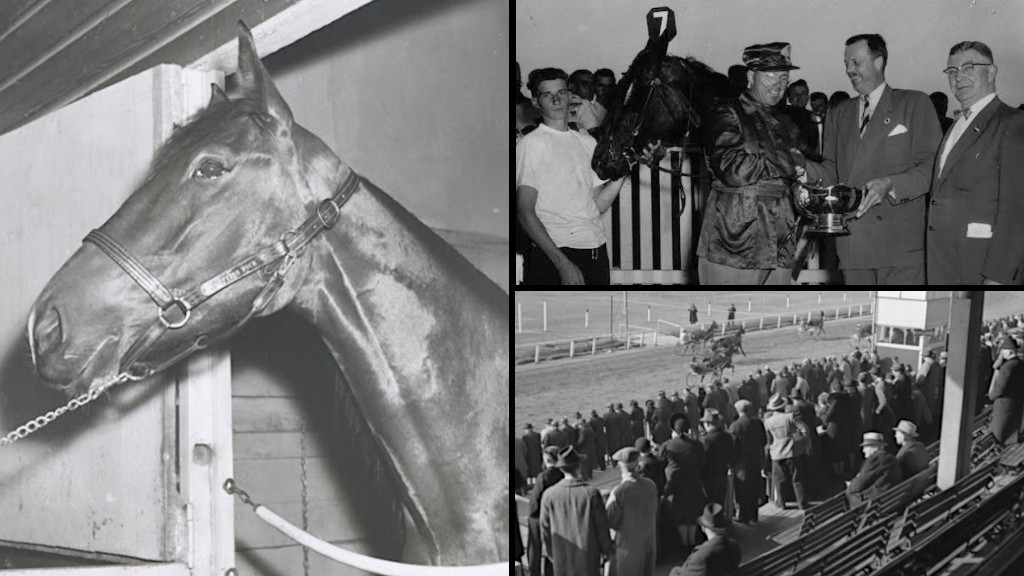
Today the monthly edition of Years Ago features a medley of names, faces, and other trivia from the decade of the 1950s. While this may seem like ancient history to many, it was not so long ago for more than a few readers of Rewind. In the U.S., new tracks were being opened, but Canadians had to wait a bit longer.
1950–51 - Harness Racing Becoming More Popular
According to a lengthy column in the Calgary Herald authored by noted sportswriter Jim Coleman back in 1951, harness racing in Canada was truly living up to its current description as “America’s Fastest Growing Sport.” He stated that, with the exception of the Maritime Provinces, in three of the previous four decades harness racing had declined in popularity. He went on to say that the sport was in the midst of an amazing comeback as the decade of the 1950s was dawning.
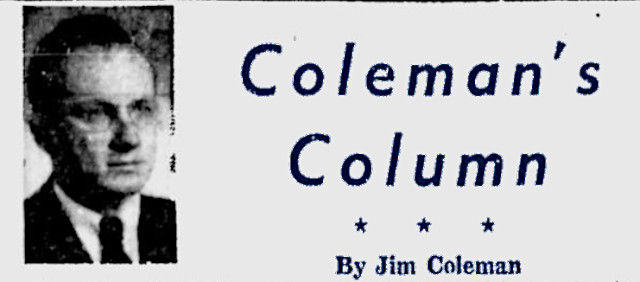
He cited the huge amount of activity taking place in the City of Toronto as a major happening. In the 1950–51 season, the venerable Dufferin Park had staged a total of 80 days of harness racing—often under trying conditions. While thoroughbred racing had been the leader here for many years, a new trend was well underway.
Another Toronto landmark, Thorncliffe Park, had been “reborn,” offering new and exciting racing features. They staged 38 days of action and paid out over $186,000 in purses. City dwellers were fast becoming fans of a sport previously enjoyed mainly by “country folk.”
Hardy racegoers watch the finish of a race at Dufferin Park. There were no glass panels to shield them from the elements. It looks like felt hats and overcoats were the order of the day.
His piece stated: “Mr. Orpen (track operator) staged 80 days of racing at his half-mile plant in Toronto, and there were afternoons when 3,500 or 4,000 stalwart customers bundled themselves in heavy clothes, clustered around the stoves in the restaurant, and then rushed into the cold to watch the trotters and pacers whirling around the track.”
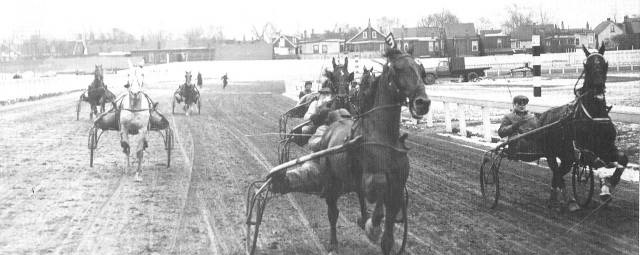
This old photo shows the finish of a race at Dufferin Park taken in 1949. The track was nestled among a city neighbourhood on Dufferin Street between College and Bloor.
1956 - New Track Record Set at Norwich, Ontario
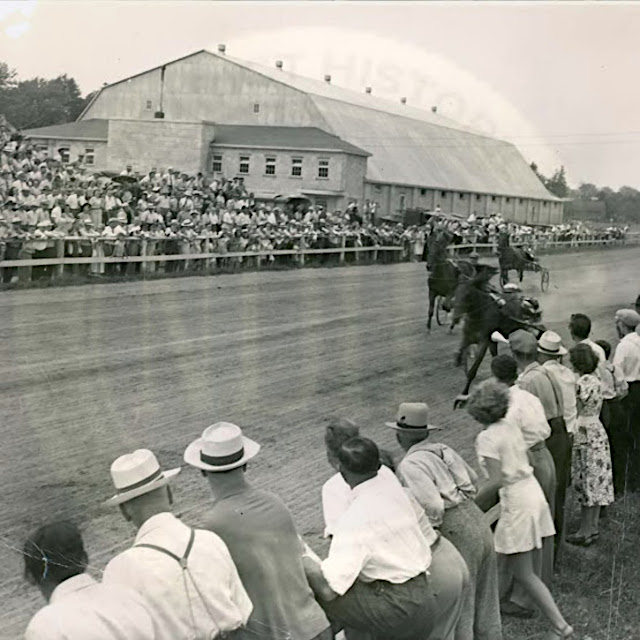
Spectators at Dillon Park in Norwich, Ontario, get a close-up view of the finish of a race at this once-popular small-town racing site. This undated photo shows the town arena in the background. Photo courtesy of the Norwich & District Historical Society.
Note – This photo was not taken on the day described below.
Back in late fall of 1956, a sort of “old-fashioned” afternoon of harness racing was held at the Norwich, Ontario, fairgrounds track. It was a bit unusual, as no purse monies were offered for any of the events. It was kind of a “fun day” for both the spectators and the competing horsemen.
The following item appeared shortly after this event in the Nov. 7, 1956 issue of Harness Horse magazine.
Lady’s Lad Sets Norwich Mark
Norwich, Ont., Canada, October 27 — Lady’s Lad, driven by Bill Harvey, reduced the track record for pacers here at Dillon Park to 2:07 4/5 this afternoon during a program of matinee racing. The new tab came in an exhibition trip without a prompter. The previous tab stood at 2:08, set in 1948 by the fleet Blue Again p, 2:02 1/4.
Lady’s Lad, a four-year-old gelding by Miller Brook out of Lady Invasion, was foaled, raised, and trained here at Dillon Park. He was trained by Andrew Bell, head trainer for the H. & B. Stable, in whose colors the gelding was currently campaigning.
Dash winners on the afternoon card were Mervin Cuthbert’s Anne Jean, driven by Almer Holmes; Running Water Farm’s Shallo Water, Ted Eaves up; and Max Featherstone’s Sonny McKinney with the owner in the sulky. A blanket was presented to each winner.
1956 - Match Race Goes to Dotties Pick
In the decade of the 1950s, one sire dominated the entire sport. His name was Adios, and everyone who had ever heard of this horse wanted to own one of his offspring (maybe several). He had been an outstanding performer in his racing days, and by this time his greatness as a sire was in full bloom.
One prominent Canadian owner was completely taken with the sons and daughters of Adios, and that man had plenty of resources and connections to secure more than a few of these prized young horses. That esteemed gentleman was Elgin Armstrong, half-owner of the up-and-coming Armbro Farms of Brampton, Ont.
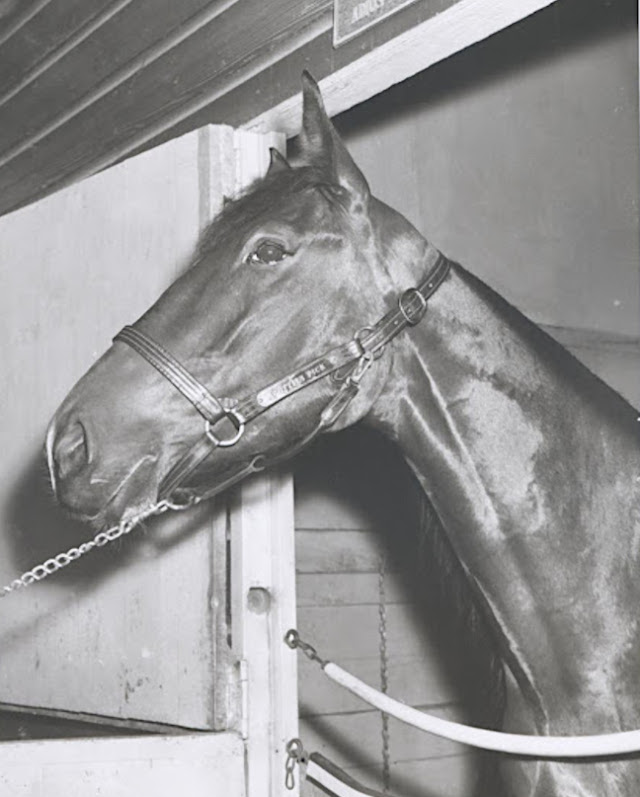
Dotties Pick in her stall (Harness Racing Museum and HOF photo )
In the fall of 1956, Mr. Armstrong was involved in quite a show of racing talent as his then four-year-old mare, Dotties Pick, was part of a very prestigious match race at Yonkers Raceway in New York. To further add to the excitement and drama, her opponent Adios Harry was also a son of Adios.
Dotties Pick, handled by Delvin Miller, was sent to the front immediately and was never headed after that. A mild challenge was mounted by Adios Harry and driver Luther Lyons at the quarter pole, but the outcome of the race was never really in question. The five-year-old mare coasted to an 11-length victory in 2:06. She paid $3.80 to her faithful backers.
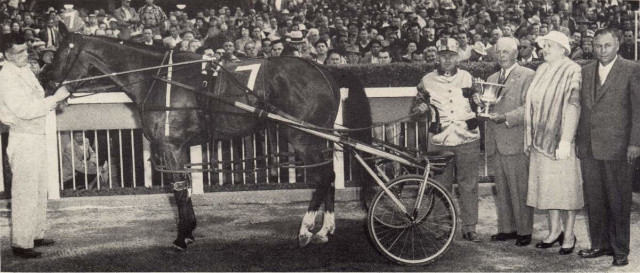
Dotties Pick shown after winning at Santa Anita Park in California. Mel Eaton of Vernon Downs was on hand to present a trophy to driver Delvin Miller and owners Victoria and Elgin Armstrong on the right. (Harness Horse photo)
Dotties Pick had a truly amazing career — first on the track and later as a highly successful broodmare. She eventually became a member of both the U.S. and Canadian Halls of Fame. She passed away at age 28 and was buried at the Armstrong Farm in Brampton, joining other greats.
1957 - Findley Stable Wins Trotting Futurity at Old Woodbine
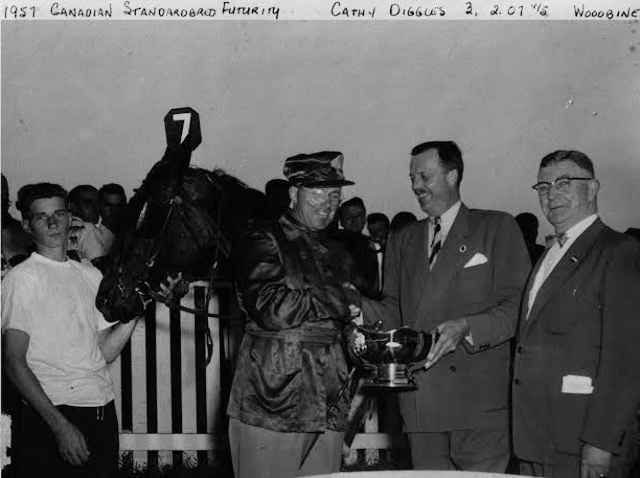
Cathy Diggles wins the 1957 CSHS Futurity. OJC chairman George Hendry presents a trophy to owner-driver John Findley. Hal B. Watson, harness racing journalist on the far right. The groom on the left was Ron Fraser of Arnprior.
In 1957, Old Woodbine was in its fourth year of hosting summer racing. The weekly schedule saw racing six afternoons per week until the track closed for the season on August 28. Weekly invitations drew some of the better horses available at that time.
Futurity races for two- and three-year-olds made up a nice addition to the regular classes, and also provided purses much larger than the condition events. At this time, no claiming races were offered. Colt racing was still not a major part of the Canadian scene, and for those who did choose to participate, the opportunities were limited.
On August 27, the three-year-old trotting futurity was contested in two heats. Eight starters made up the field, and the winner of both heats was the filly Cathy Diggles. She was a homebred daughter of Ezra Blue, and her dam was Sheila Lee — a mare that owner Dr. John Findley and his father had raised on their Arnprior farm and also raced.
The 33-year-old Findley was still practicing veterinary medicine as well as racing a number of horses. Cathy Diggles had a productive campaign that year, winning seven of her 12 starts and finishing second in each of her other outings. Her season’s earnings were $4,586 — a very good showing back then.
Her winning time of 2:07 4/5 set a new futurity record, erasing the existing mark of 2:08.2 set in 1953 by Ben Boy (Keith Waples). It was Cathy Diggles’ season record and also established a new track record at Old Woodbine. In 1962, Betsy Herbert lowered the standard to 2:07.
Quote for the Week: Comedian Henny Youngman went to his doctor and reported that he had broken his leg in two places. The doctor promptly replied, “If you expect me to continue to be your doctor, don’t go back to either one of those two places again!”
Who Is It?
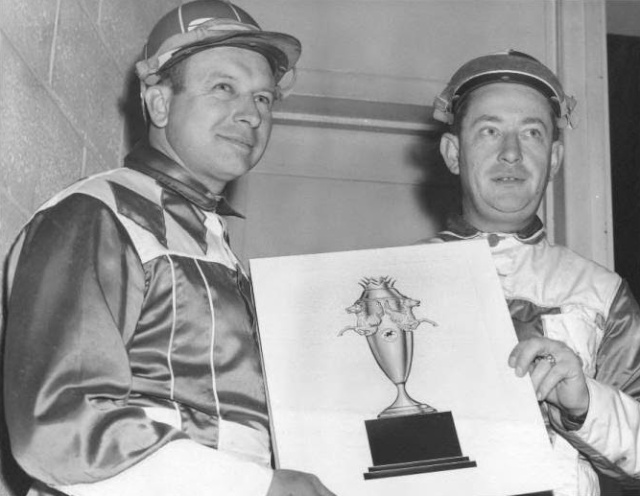
Can you identify these two fellows? Both were popular trainers and drivers.
Who Else Is It?
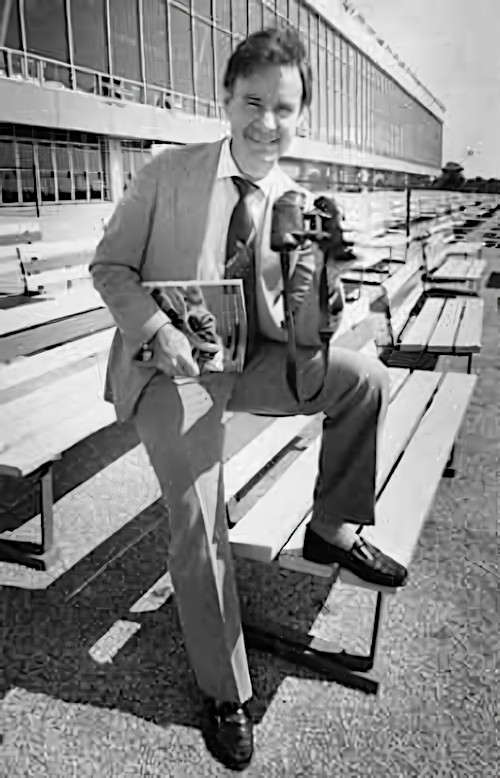
Can you identify this dapper young fellow? He looks to be armed and ready to do his job, but might have to climb a few stairs to get to his “office.” Who is he?
(The correct answers will be posted here by Robert as a comment in a few days.)


This week's picture answers
This week's Quiz photos were solved once again by our experts. Correct answers are shown below:
Who is it? On the left was Howard Beissinger, on the right Wm. R. "Billy " Haughton, a couple of very fine horsemen.
Who else is it? was that "smooth talkin' guy " Frank Salive. His race calls thrilled millions for years and years. Thanks to everyone for your answers and special comments such as the one this week from Mark McLennan. Always interesting.
Frank Salive
Singer Mel Torme was the original Velvet Fog.
rewind
I have a copy of that picture of Cathy Diggles - the older sister of Hall of Famer Dalyce Blue.
She was a fall foal , which made her accomplishment a little more amazing.
I believe that race was also her lifetime mark.
My friend John did my family the honour of naming one of her foals McLennan, who was not a star, but a useful racehorse.
As always, Robert, thank for the memories.
Who is it? Howard Beissinger…
Who is it?
Howard Beissinger & William Haughton
Who else is it?
Frank Salive
Thank you Robert!
Who is it? Howard bessinger…
Who is it?
Howard bessinger and billy houton
Who else is it?
Frank bezare
The Velvet Fog
The one and only Frank Salive Not sure where he got that nickname. I might have called him something different maybe a nod to his playing days as a goalie some said he was decent i might have said the sive. Just kidding Frank regards Armbro Sarcasm
Who is it Billy Haughton …
Who is it Billy Haughton Howard Beisinger Who else is it Frank Salive
Who is it? Howard Beissinger…
Who is it? Howard Beissinger and William Haughton.
Who else is it? Frank Salive.
Howard Biesinger, Bill…
Howard Biesinger, Bill Haughton and of course the Velvet Fog!